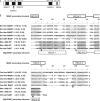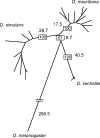Recurrent positive selection of the Drosophila hybrid incompatibility gene Hmr
- PMID: 18755760
- PMCID: PMC2727392
- DOI: 10.1093/molbev/msn190
Recurrent positive selection of the Drosophila hybrid incompatibility gene Hmr
Abstract
Lethality in hybrids between Drosophila melanogaster and its sibling species Drosophila simulans is caused in part by the interaction of the genes Hybrid male rescue (Hmr) and Lethal hybrid rescue (Lhr). Hmr and Lhr have diverged under positive selection in the hybridizing species. Here we test whether positive selection of Hmr is confined only to D. melanogaster and D. simulans. We find that Hmr has continued to diverge under recurrent positive selection between the sibling species D. simulans and Drosophila mauritiana and along the lineage leading to the melanogaster subgroup species pair Drosophila yakuba and Drosophila santomea. Hmr encodes a member of the Myb/SANT-like domain in ADF1 (MADF) family of transcriptional regulators. We show that although MADF domains from other Drosophila proteins have predicted ionic properties consistent with DNA binding, the MADF domains encoded by different Hmr orthologs have divergent properties consistent with binding to either the DNA or the protein components of chromatin. Our results suggest that Hmr may be functionally diverged in multiple species.
Figures



References
-
- Aasland R, Stewart AF, Gibson T. The SANT domain: a putative DNA-binding domain in the SWI-SNF and ADA complexes, the transcriptional co-repressor N-CoR and TFIIIB. Trends Biochem Sci. 1996;21:87–88. - PubMed
-
- Bachtrog D, Thornton K, Clark A, Andolfatto P. Extensive introgression of mitochondrial DNA relative to nuclear genes in the Drosophila yakuba species group. Evol Int J Org Evol. 2006;60:292–302. - PubMed
Publication types
MeSH terms
Substances
Grants and funding
LinkOut - more resources
Full Text Sources
Molecular Biology Databases
Miscellaneous

